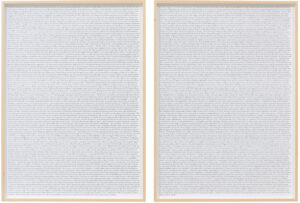At Studio G7 Gallery the exhibition “The Beginning The End” will be open until February 20: it is a new project by Daniela Comani that collects 424 quotes taken from classical, contemporary and genre fiction. The artist has selected 212 Italian and foreign novels, from each of which she has extracted the first and the final sentences. Arranging these literary fragments on her work table, she then composed a new story as if it were a collage, putting the beginnings in logical-narrative connection and arranging the sequence of ends in a mirror image. In this act of appropriation, Comani deepens her ten-year research on the manipulation of the story, also at the center of other important projects carried out during her career, such as “It was me. Diary 1900-1999 “(2002) or the cycle “Editorial news” (2007 – in progress). Here too the heart of the project is a book, in this case to be read in two verses, where the story of the beginnings meets halfway with that of the ends. As in the previous series, the alterations of meaning made by the artist trigger a proliferation of alternative narratives, which in the original text are already implicitly latent, but invisible, because they are imprisoned in the semantic meshes of language and its more or less conscious cultural and ideological presuppositions.
The two stories that make up “The Beginning The End” unfold in the spaces of intersection and overlap identified by Daniela Comani and give life to a breathless and potentially infinite reading, which puts a strain on the reader’s ability to orient. The process, founded on aesthetic, literary and logical associations mysteriously pertinent in their arbitrariness, ends up questioning our confidence in the usefulness of language in circumscribing, disciplining and framing the multiplicity of events in life and thought, highlighting how it is consequence of a mental construction in which subjectivity is always preponderant. But, at the same time, the compelling cohesion of the two sequences of literary fragments creates an impression of ineluctable circularity, through which an idea of exactness and predestination transpires that overcomes any rational reserve in the name of a renewed faith in the word as effective instrument of truth and knowledge. The complexity of the project does not prevent Daniela Comani from having fun, on the contrary the formal essentiality of the graphics of the book (and of the other two works on show that derive from it) seem to emphasize rather than hide her propensity for ironic and unsettling combinations and her complete disregard for any easy combinatorial opportunism.
The reading offers a series of precious divertissements, such as the contiguity of the first verses of the Gospel according to John and the incipit of The tin drum by Günter Grass, in which the narrator tells of being hospitalized in an asylum under the constant observation of a nurse through the peephole of the door, or the consequentiality between the slippery sentimental exaltations of Humbert Humbert in Lolita, and the lapidary male-dominated observation with which Ian Fleming concludes Casino Royale. The collision between these (and other) originally distinct universes of meaning is supported by a temporal scan that manages to be impeccable in its apparent randomness, as it can be seen, for example, by the punctual succession of the seasons, months and phases of the day in the story of begins (which begins in a summer sunrise and ends in spring). Through Daniela Comani’s manipulation, the singularity of each narrative event becomes an exact but interchangeable component of a polyphonic text that transforms the reading, and potentially the entire narrative heritage of universal culture, into an uninterrupted, homogeneous and chameleontically adaptable flow. And perhaps even more surprising is to note how in the sampling of the texts selected by the artist the end is never definitive, but almost always eluded by words that express a doubt or an expectation, as if they were so many preludes of possible future developments yet to be told.
The book, printed in a limited edition in pocket format, explains the structure of the artist’s intuition and her freely philological method, based on surgical procedures of condensation and displacement that always generate a rewriting of the original sources. As in the other projects mentioned, even in “The Beginning The End” the written text, after becoming a new book, is visually translated into other expressive languages that further untie the conventionality of words, as elements of a linguistic code that we now suspect no longer being so univocal, starting from their albeit minimal graphic and formal component. In the two works that complete the exhibition, in fact, the words take on an ontologically ambiguous value even under an empirical observation, to become spatial and compositional elements, as well as conceptual, and ultimately even objects. In the diptych exhibited in the gallery, made of two printed posters showing, respectively, the sequence of the beginnings and that of the ends, the artist with imperceptible adjustments of spacing and graphic adaptations creates the illusion that the two stories contain almost the same quantity of letters, while in the three large canvases that stand out on the opposite wall the story is fragmented in its linguistic ramifications and takes on the fictitious three-dimensionality of a collection of paper catalog cards that materialize Daniela Comani’s obsessive fidelity to the fact that systematically she seems to betray and neutralize. And it is precisely this capillary ability of hers to pursue a minimalist intervention strategy to obtain striking reversals of perspective is, in my opinion, the expressive charactristic that distinguishes her language in the contemporary art scene, fully confirmed by the current exhibition.
Info:
Daniela Comani. The Beginning / The End
11 December 2020 – 20 February 2021
Texts by Matteo Bergamini and Veronica Santi
Galleria Studio G7
Via Val D’Aposa 4/A, Bologna




Daniela Comani, THE BEGINNING THE END / L’INIZIO LA FINE, exhibition view, courtesy Galleria Studio G7, Bologna, foto Alessandro Fiamingo
 Daniela Comani, The Beginning / The End, 2020, pigment print su Photo Rag, due elementi, cm 70×50 cad., ed.5, Courtesy l’artista e Galleria Studio G7, Bologna. Foto Alessandro Fiamingo
Daniela Comani, The Beginning / The End, 2020, pigment print su Photo Rag, due elementi, cm 70×50 cad., ed.5, Courtesy l’artista e Galleria Studio G7, Bologna. Foto Alessandro Fiamingo
Graduated in art history at DAMS in Bologna, city where she continued to live and work, she specialized in Siena with Enrico Crispolti. Curious and attentive to the becoming of the contemporary, she believes in the power of art to make life more interesting and she loves to explore its latest trends through dialogue with artists, curators and gallery owners. She considers writing a form of reasoning and analysis that reconstructs the connection between the artist’s creative path and the surrounding context.






NO COMMENT